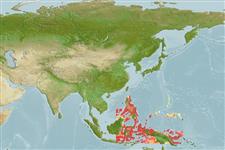>
Gobiiformes (Gobies) >
Gobiidae (Gobies) > Gobiinae
Etymology: Trimma: Greek, trimma, -atos = something crushed (Ref. 45335); trioculatum: Name derived from 'tri' for three and 'oculatus' for having eyes; referring to the extra apparent eye formed by the dark ocellated spot in the first dorsal fin.
Environment: milieu / climate zone / depth range / distribution range
Ecologie
marien rifbewoner; diepte 5 - 71 m (Ref. 102609). Tropical; 20°N - 9°S, 114°E - 154°E
Western Pacific: known with certainty from Indonesia. Non-types collected from Palau, Papua New Guinea and the Philippines.
Grootte / Gewicht / Leeftijd
Maturity: Lm ? range ? - ? cm
Max length : 1.9 cm SL mannelijk / geslacht onbekend; (Ref. 102609); 1.7 cm SL (female)
Korte beschrijving
Determinatiesleutels | Morfologie | Morfometrie
Dorsale stekels (totaal) : 7; Dorsale zachte stralen (totaal) : 8 - 9; Anale stekels: 1; Anale zachte stralen: 8. This species is distinguished by the following characters: first dorsal fin with a large (slightly greater than pupil diameter in width) round, black, ocellated spot in between spines 1 and 5; a second, much smaller black or dark red spot just posterior to the spine of the second dorsal fin and above the basal stripe; body yellow with a dark purplish or gray head with two distinct red bars across the cheek; without round spots of any colour on the nape, opercle or cheek; upper pectoral fin base with a small dark (preserved) or white (alive) spot; a narrow bony interorbital (<70% pupil diameter); first dorsal fin without elongated spines; pectoral fin rays 15-16, with the middle 4-8 rays branched; fifth pelvic fin ray with a single dichotomous branch; total gill rakers on the first gill arch 16-17 (Ref. 102609).
Inhabits steep outer reef walls, often present in groups of up to 20 individuals which are loosely aggregated and perched vertically on the substrate at the back of small overhangs and crevices. Non-type specimens collected were also nearly always found on steep outer reef walls (Ref. 102609).
Levenscyclus en paargedrag
Maturiteit | Voortplanting | Paaien | Eieren | Fecunditeit | Larven
Winterbottom, R., M.V. Erdmann and N.K.D. Cahyani, 2015. New species of Trimma (Actinopterygii, Gobiidae) from Indonesia, with comments on head papillae nomenclature. Zootaxa 3973(2):201-226. (Ref. 102609)
Status op de Rode Lijst van het IUCN (Ref. 130435: Version 2024-2)
Gevaar voor de mens
Harmless
Gebruik door de mens
Visserij: van geen belang
Tools
Speciale rapporten
Download XML
Internetbronnen
Estimates based on models
Preferred temperature (Ref.
123201): 28 - 29.1, mean 28.6 °C (based on 68 cells).
Fylogenetische diversiteitsindex (Ref.
82804): PD
50 = 0.5000 [Uniqueness, from 0.5 = low to 2.0 = high].
Bayesian length-weight: a=0.00724 (0.00339 - 0.01546), b=3.10 (2.92 - 3.28), in cm total length, based on LWR estimates for this (Sub)family-body shape (Ref.
93245).
Weerstandsvermogen (Ref.
120179): Hoog, minimale populatieverdubbelingstijd minder dan 15 maanden (Preliminary K or Fecundity.).
Fishing Vulnerability (Ref.
59153): Low vulnerability (10 of 100).
